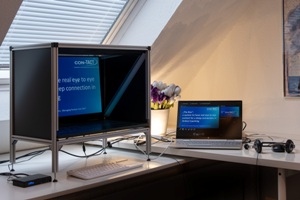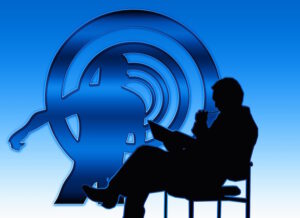How can you enhance the perception being in a room when meeting online and not just seeing each other on a flat screen?
Working from home is more common than ever in organisations. And it may stay like this long after the current pandemic – at least to a certain extent. When speaking with clients and people in my network the most common response I get about the negative side of working from home is that they miss the real connection to colleagues. When exploring this further, many point out that they even don’t see each other at all, as they are reluctant to use the video connection from the home.
I was first puzzled, but conversations revealed that quite a few people have concerns about their privacy being exposed to others. Some are concerned about the appearance of the rooms they must sit in. Sometimes the bedroom is the only space available or the living room is a very open room, or the office is just a mess. Neither do they want to show their colleagues. And that is understandable.
Technical options and challenges
The most often used platforms offer features of digital processing of the background. They either have a functionality of blurring the actual background, like Teams and Skype, or they use virtual backgrounds, like Teams or Zoom, with digital images offered by the provider or the option to using your own. The challenge is to pay attention to the technical requirements of this functionality so they provide good quality backgrounds.
Issues can be:
- when people move, parts of their body suddenly disappear in the background picture and re-emerge seconds later
- parts of the person are blurred together with the background
Both can be quite annoying and distracting. These digital glitches usually happen when the colour contrast between the background and the person is not significant enough. Hence, this functionality works best with a uniformly coloured background, ideally a green screen, but at least a colour that is different to whatever colours are around the persons ‘edges’. Means: someone with black hair should not sit in front of a dark wall, or a white haired person better not sit in front of a white wall. The same applies to clothes.
It still doesn’t feel right – why’s that?
Still people say “it still feels artificial as I see my colleague on a flat screen” when they use these functionalities.
Of course, we are all conditioned that meetings take place in a room. Therefore, to feel connected, we want to be in the same room with the person we are meeting .

There is another aspect to be aware of – spatial impression.
In order to avoid the issue with distracting backgrounds at home or just private spaces many people place themselves in front of a plain white wall when participating in a virtual meeting. The problem is that this deprives us from any spatial impression and so enhances the feeling of being seen on a flat screen.
The truth is, that in order to feel like being in a room, our brain needs to have the impression that we are in a room. You could say it wants to be fooled. And it only takes images with lines converging at a vanishing point to trick our brain into the perception of a 3D-space. Therefore, providing clues in the background to support this spatial impressions can help our brain – or that of our conversation partners – to create the feeling of being in a room, at least on the subconscious level.
And here comes my tip how you can create such impressions through various means.
Creating the impression of a room
When using the functionalities of a virtual background, select images which have the above described spatial effects of converging lines. I am confident you will agree that the image below already proves my point when compared with the flat white wall in the background of the image above.

Two non-digital options to mitigate the issue
And if you don’t like the effects of virtual backgrounds, leaving funny artifacts on the boundaries between the real person and the digital background, I have two other ideas that could work for you depending on the arrangements you can make in your actual physical room or office space and the effort you want to put into it.
Rather than going digital you can create a ‘real’ background with such an image.
One option would be to get an appropriate image printed on a banner. They are available online at very reasonable prices these days. Then, when you are in a video conference, simply hang it up behind you or place yourself in front of it, depending on what is easier.
For this to work though, you need to make sure the size is sufficient to fill your WebCam frame, otherwise it would look slightly odd. Here is just one of many companies that provides such services and they will normally tell you the image resolution required to print large formats.
The second option is especially useful, if you are not mobile with your computer and don’t have a wall directly behind you: rollup banners. They can also be printed with any image you like but are just more expensive than the simple banner I mentioned above. Here too it is important to make sure that the size is appropriate for the conditions in your office (or meeting) space. The beauty of the rollup is that it is easy enough to be stowed away in comparison to the banner. Here is also one of many sites where you can get these.
I have been using the first option for quite a while now and even have different banners that I can chose depending on the client or the organisation I work with.

Conclusion
Paying attention to your background in virtual meetings can change the way the meeting is perceived. With a few clues you can create a spatial impression that helps people to feel more like being in a room with you than speaking with you via a flat screen.
I hope this helps you to be more effective and comfortable with online meetings and provide an impression of a room meeting. And if you have any questions about this or want to discuss details feel free to leave a comment below or get in touch with me direct.



